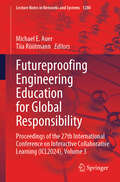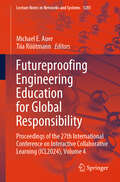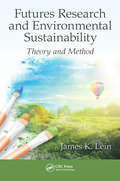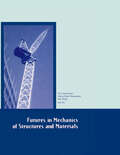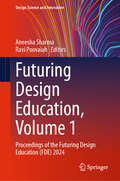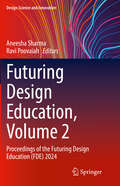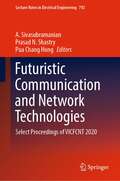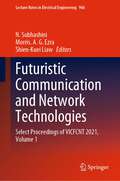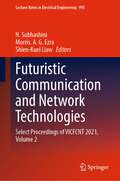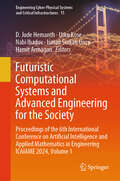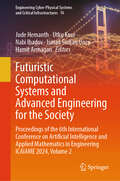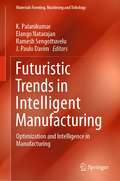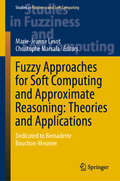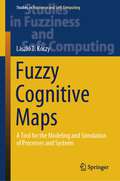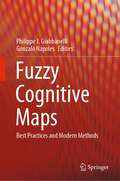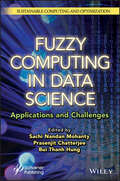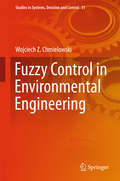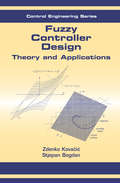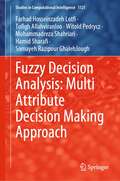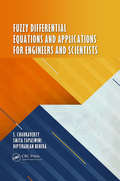- Table View
- List View
Futureproofing Engineering Education for Global Responsibility: Proceedings of the 27th International Conference on Interactive Collaborative Learning (ICL2024), Volume 3 (Lecture Notes in Networks and Systems #1280)
by Michael E. Auer Tiia RüütmannThis book contains papers in the fields of: Green transition in education. New generation of engineering students. Entrepreneurship in engineering education. Open education best practices. Project-based learning (PBL). Teaching best practices. We are currently witnessing a significant transformation in the development of education on all levels and especially in post-secondary and higher education. To face these challenges, higher education must find innovative and effective ways to respond in a proper way. Changes have been made in the way we teach and learn, including the massive use of new means of communication, such as videoconferencing and other technological tools. Moreover, the current explosion of artificial intelligence tools is challenging teaching practices maintained for centuries. Scientifically based statements as well as excellent best practice examples are necessary for effective teaching and learning engineering. The 27th International Conference on Interactive Collaborative Learning (ICL2024) and 53rd Conference of International Society for Engineering Pedagogy (IGIP), which took place in Tallinn, Estonia, between September 24 and 27, 2024, was the perfect place where current trends in Higher Education were presented and discussed. IGIP conferences have been held since 1972 on research results and best practices in teaching and learning from the point of view of engineering pedagogy science. ICL conferences have been held since 1998 being devoted to new approaches in learning with a focus on collaborative learning in higher education. Nowadays, the ICL conferences are a forum of the exchange of relevant trends and research results as well as the presentation of practical experiences in learning and engineering pedagogy. In this way, we try to bridge the gap between ‘pure’ scientific research and the everyday work of educators. Interested readership includes policymakers, academics, educators, researchers in pedagogy and learning theory, schoolteachers, learning industry, further and continuing education lecturers, etc.
Futureproofing Engineering Education for Global Responsibility: Proceedings of the 27th International Conference on Interactive Collaborative Learning (ICL2024), Volume 4 (Lecture Notes in Networks and Systems #1281)
by Michael E. Auer Tiia RüütmannThis book contains papers in the fields of: Virtual and augmented learning. Games in engineering education. Social aspects of digitalization. Technical teacher training. Accessible learning and technologies. Dance of data in educational science and practice. Engineering education for production and service structures of the future. Innovative approaches to STEAM education and music therapy through emerging technologies. We are currently witnessing a significant transformation in the development of education on all levels and especially in post-secondary and higher education. To face these challenges, higher education must find innovative and effective ways to respond in a proper way. Changes have been made in the way we teach and learn, including the massive use of new means of communication, such as videoconferencing and other technological tools.
Futures Research and Environmental Sustainability: Theory and Method
by James K. LeinThis book explores the challenges of presenting sustainability as a more actionable or practical concept and identifying approaches that might offer useful assistance in addressing the temporal and spatial representation of sustainability. The underlying premise of this book is that sustainability is a state realized in the future. In that future there is a geographic arrangement of society and economy that agrees with its environmental setting. This future perspective introduces a little examined subject area that can lend significant content to the sustainability challenge: Futures Research.
Futures in Mechanics of Structures and Materials
by Hao Wang Thiru Aravinthan Warna Karu KarunasenaFutures in Mechanics of Structures and Materials is a collection of peer-reviewed papers presented at the 20th Australasian Conference on the Mechanics of Structures and Materials (ACMSM20, University of Southern Queensland, Toowoomba, Queensland, Australia, 2 - 5 December 2008) by academics, researchers and practicing engineers mainly from Austral
Futuring Design Education, Volume 1: Proceedings of the Futuring Design Education (FDE) 2024 (Design Science and Innovation)
by Ravi Poovaiah Aneesha SharmaThis book presents select proceedings of the two-day conference titled Futuring Design Education (FDE 2024), and it examines the transformation of design knowledge, the evolving spaces of learning, and the ecosystems of teaching and learning. The topics covered include the pedagogical model of design education, the experiments, and technological advances that impact design education. The book also discusses the roles and challenges of learning spaces, remote learning in digital spaces, and synchronous and asynchronous learning tools. The book will also look at the social contexts in design pedagogy, cultural affiliations and alignments and will allude to any new learning frameworks for design education. The book can be a valuable reference for design educators, design researchers, and professionals interested in design education.
Futuring Design Education, Volume 2: Proceedings of the Futuring Design Education (FDE) 2024 (Design Science and Innovation)
by Ravi Poovaiah Aneesha SharmaThis book presents select proceedings of the two-day conference titled Futuring Design Education (FDE 2024), and it examines the transformation of design knowledge, the evolving spaces of learning, and the ecosystems of teaching and learning. The topics covered include the pedagogical model of design education, the experiments, and technological advances that impact design education. The book also discusses the roles and challenges of learning spaces, remote learning in digital spaces, and synchronous and asynchronous learning tools. The book will also look at the social contexts in design pedagogy, cultural affiliations and alignments and will allude to any new learning frameworks for design education. The book can be a valuable reference for design educators, design researchers, and professionals interested in design education.
Futuristic Communication and Network Technologies: Select Proceedings of VICFCNT 2020 (Lecture Notes in Electrical Engineering #792)
by A. Sivasubramanian Prasad N. Shastry Pua Chang HongThis book presents select proceedings of the International Conference on Futuristic Communication and Network Technologies (CFCNT 2020) conducted at Vellore Institute of Technology, Chennai. It covers various domains in communication engineering and networking technologies. This volume comprises of recent research in areas like optical communication, optical networks, optics and optical computing, emerging trends in photonics, MEMS and sensors, active and passive RF components and devices, antenna systems and applications, RF devices and antennas for microwave emerging technologies, wireless communication for future networks, signal and image processing, machine learning/AI for networks, internet of intelligent things, network security and blockchain technologies. This book will be useful for researchers, professionals, and engineers working in the core areas of electronics and communication.
Futuristic Communication and Network Technologies: Select Proceedings of VICFCNT 2021, Volume 1 (Lecture Notes in Electrical Engineering #966)
by Shien-Kuei Liaw N. Subhashini Morris. A. G. EzraThis book presents select proceedings of the Virtual International Conference on Futuristic Communication and Network Technologies (VICFCNT 2021). It covers various domains in communication engineering and networking technologies. This volume comprises recent research in areas like cyber-physical systems, acoustics, speech & video signal processing, and IoT. This book is a collated work of academicians, researchers, and industry personnel from the international arena. This book will be useful for researchers, professionals, and engineers working in the core areas of electronics and communication.
Futuristic Communication and Network Technologies: Select Proceedings of VICFCNT 2021, Volume 2 (Lecture Notes in Electrical Engineering #995)
by Shien-Kuei Liaw N. Subhashini Morris. A. G. EzraThis book presents select proceedings of the Virtual International Conference on Futuristic Communication and Network Technologies (VICFCNT 2021). It covers various domains in communication engineering and networking technologies. This volume comprises recent research in areas like cyber-physical systems, acoustics, speech & video signal Processing, and the Internet of Things. This book is a collated work of academicians, researchers, and industry personnel from the international arena. This book will be useful for researchers, professionals, and engineers working in the core areas of electronics and communication.
Futuristic Computational Systems and Advanced Engineering for the Society: Proceedings of the 6th International Conference on Artificial Intelligence and Applied Mathematics in Engineering ICAIAME 2024, Volume 1 (Engineering Cyber-Physical Systems and Critical Infrastructures #15)
by D. Jude Hemanth Utku Kose Nabi Ibadov Ismail Serkan Uncu Hamit ArmaganThis book provides the most recent, quality research papers accepted and presented in the 6th International Conference on Artificial Intelligence and Applied Mathematics in Engineering (ICAIAME 2024), held in 26-27-28 September 2024 at Warsaw, Poland. Objective of the book is to provide important and innovative research for developments—improvements within different engineering fields, which are highly interested in using artificial intelligence and applied mathematics. As a collection of the outputs from ICAIAME 2024, the book ensures a perspective in terms of especially futuristic solution approaches to advance the society through innovative engineering efforts. The book allows researchers and practitioners from both academia as well as industry to exchange, share their ideas and keep themselves up to date (in terms of knowledge) in the context of the latest research efforts and further opportunities arising. As the proceedings of the ICAIAME 2024, the book eventually plays a remarkable, active role in accumulating the most recent, significant works of artificial intelligence and applied mathematics to shape both the present and future of engineering disciplines.
Futuristic Computational Systems and Advanced Engineering for the Society: Proceedings of the 6th International Conference on Artificial Intelligence and Applied Mathematics in Engineering ICAIAME 2024, Volume 2 (Engineering Cyber-Physical Systems and Critical Infrastructures #16)
by Jude Hemanth Utku Kose Nabi Ibadov Ismail Serkan Uncu Hamit ArmaganThis book provides the most recent, quality research papers accepted and presented in the 6th International Conference on Artificial Intelligence and Applied Mathematics in Engineering (ICAIAME 2024), held in 26-27-28 September 2024 at Warsaw, Poland. Objective of the book is to provide important and innovative research for developments—improvements within different engineering fields, which are highly interested in using artificial intelligence and applied mathematics. As a collection of the outputs from ICAIAME 2024, the book ensures a perspective in terms of especially futuristic solution approaches to advance the society through innovative engineering efforts. The book allows researchers and practitioners from both academia as well as industry to exchange, share their ideas and keep themselves up to date (in terms of knowledge) in the context of the latest research efforts and further opportunities arising. As the proceedings of the ICAIAME 2024, the book eventually plays a remarkable, active role in accumulating the most recent, significant works of artificial intelligence and applied mathematics to shape both the present and future of engineering disciplines.
Futuristic Manufacturing: Perpetual Advancement and Research Challenges (Science, Technology, and Management)
by J. Paulo Davim Mithilesh K. Dikshit Vimal Kumar Pathak Asit Baran PuriIncreased industrial capacity, manufacturing output, and manufacturing technology all contribute significantly to a country's GDP. Manufacturing is the foundation of industrial production, so improving its methods and infrastructure is crucial for progress. Recent years have seen the introduction of a wide range of energy- and resource-efficient, environmentally friendly, and occupationally safe manufacturing techniques, and this book focuses on these latest techniques, as well as continuous advancement, in order to meet current challenges. The book is divided into three sections: (1) subtractive manufacturing, (2) additive manufacturing, and (3) the use of artificial intelligence in manufacturing. It discusses micromaching, metal-based additive manufacturing, polymer-based additive manufacturing, hybrid additive manufacturing, and finally artificial intelligence in manufacturing. Futuristic Manufacturing: Perpetual Advancement and Research Challenges connects modern manufacturing methods and emerging trends in the industry. It adds a thorough examination of modern manufacturing techniques and modifications that may be implemented in the future, and is an excellent resource of information for undergraduate and graduate students in manufacturing.
Futuristic Research Trends and Applications of Internet of Things
by Anshul Verma Shekhar Verma Bhawana Rudra Bhanu ShresthaThe Internet of Things (IoT) is an interconnection of several devices, networks, technologies, and human resources to achieve a common goal. A variety of IoT-based applications are being used in different sectors and have succeeded in providing huge benefits to the users. As a revolution, IoT overtook the entire global landscape with its presence in almost every sector, including smart cities, smart grid, intelligent transportation, healthcare, education, and so on. This technological revolution also moved to the machines, converting them into intelligent computers that can make real-time decisions and communicate with each other, forming an Internet of Systems/Machines. The use of secure light-weight protocols will help us in developing environment-friendly and energy-efficient IoT systems. IoT is an emerging and recent area of research, adopted for many applications, and there is a need to investigate further challenges in all aspects of it. This book will provide information on fundamentals, architectures, communication protocols, use of AI, existing applications, and emerging research trends in IoT. It follows a theoretical approach to describe the fundamentals for beginners as well as a practical approach with the implementation of case studies for intermediate and advanced readers. The book will be beneficial for academicians, researchers, developers, and engineers who work in or are interested in fields related to IoT. This book serves as a reference for graduate and postgraduate courses in computer science, computer engineering, and information technology streams.
Futuristic Trends in Intelligent Manufacturing: Optimization and Intelligence in Manufacturing (Materials Forming, Machining and Tribology)
by J. Paulo Davim K. Palanikumar Elango Natarajan Ramesh SengottuveluThis book shows how Industry 4.0 is a strategic approach for integrating advanced control systems with Internet technology enabling communication between people, products and complex systems. It includes processes such as machining features, machining knowledge, execution control, operation planning, machine tool selection and cutting tool. This book focuses on different articles related to advanced technologies, and their integration to foster Industry 4.0, being useful for researchers as well as industrialists to refer and utilize the information in production control.
Futuristic Trends in Numerical Relaying for Transmission Line Protections (Energy Systems in Electrical Engineering)
by Nilesh Chothani Ujjaval Patel Praghnesh BhattThis book presents the state-of-the-art approach for transmission line protection schemes for smart power grid. It provides a comprehensive solution for real-time development of numerical relaying schemes for future power grids which can minimize cascade tripping and widespread blackout problems prevailing all around the world. The book also includes the traditional approach for transmission line protection along with issues and challenges in protection philosophy. It highlights the issues for sheltering power grid from unwanted hazards with very fundamental approach. The book follows a step-by-step approach for resolving critical issues like high impedance faults, power swing detection and auto-reclosing schemes with adaptive protection process. The book also covers the topic of hardware solution for real-time implementation of auto-reclosing scheme for transmission line protection schemes along with comparative analysis with the recently developed analytical approach such as Artificial Neural Network (ANN), Support Vector Machine (SVM) and other machine learning algorithms. It will be useful to researchers and industry professionals and students in the fields of power system protection.
Fuzzy Analytic Hierarchy Process
by Ali Emrouznejad William HoThis book is the first in the literature to present the state of the art and some interesting and relevant applications of the Fuzzy Analytic Hierarchy Process (FAHP). The AHP is a conceptually and mathematically simple, easily implementable, yet extremely powerful tool for group decision making and is used around the world in a wide variety of decision situations, in fields such as government, business, industry, healthcare, and education. The aim of this book is to study various fuzzy methods for dealing with the imprecise and ambiguous data in AHP. Features: First book available on FAHP. Showcases state-of-the-art developments. Contains several novel real-life applications. Provides useful insights to both academics and practitioners in making group decisions under uncertainty This book provides the necessary background to work with existing fuzzy AHP models. Once the material in this book has been mastered, the reader will be able to apply fuzzy AHP models to his or her problems for making decisions with imprecise data.
Fuzzy Approaches for Soft Computing and Approximate Reasoning: Dedicated to Bernadette Bouchon-Meunier (Studies in Fuzziness and Soft Computing #394)
by Marie-Jeanne Lesot Christophe MarsalaThis book gathers cutting-edge papers in the area of Computational Intelligence, presented by specialists, and covering all major trends in the research community in order to provide readers with a rich primer. It presents an overview of various soft computing topics and approximate reasoning-based approaches, both from theoretical and applied perspectives. Numerous topics are covered: fundamentals aspects of fuzzy sets theory, reasoning approaches (interpolative, analogical, similarity-based), decision and optimization theory, fuzzy databases, soft machine learning, summarization, interpretability and XAI. Moreover, several application-based papers are included, e.g. on image processing, semantic web and intelligent tutoring systems. This book is dedicated to Bernadette Bouchon-Meunier in honor of her achievements in Computational Intelligence, which, throughout her career, have included profuse and diverse collaborations, both thematically and geographically.
Fuzzy Cognitive Maps: A Tool for the Modeling and Simulation of Processes and Systems (Studies in Fuzziness and Soft Computing #427)
by László T. KóczyThis book is considered as a monograph but also as a potential textbook for graduate students, focusing on the application of FCMs for modelling and analysing the behaviour of multicomponent systems. In the last two decades, no monograph or textbook has been published on the topic Fuzzy Cognitive Maps (FCM), so this new book is definitely filling a gap in the literature of computational intelligence. The book is built up didactically, the novel results in the field being presented in the way of starting with two real-life case studies, one in the area of waste management, while the other one in modelling bank management systems. In both cases, the book starts with explaining the applied problem and then presenting how the model construction is done and what problems emerge when attempts are made for applying directly earlier results on FCM modelling. In the first case study, the problem of the oversimplification leads to inadequacy of the model, and then it is shown how new, much finer models can be built up based on expert domain knowledge. Then, the new problem of losing transparency and interpretability emerges, and as a solution, a new algorithm family is proposed that reduces FCMs to fewer components, while preserving the essential characteristics of the original model.The second case study raises the problems of stability and sensitivity of FCMs, especially, considering that expert knowledge is often uncertain and subjective. The new results summarised in the book target the questions of how to ascertain whether an FCM is converging to one or several fixed point attractors, whether there is a bifurcation when parameters are changing, etc. Both problems deal with the ultimate question whether the system modelled is stable and sustainable.
Fuzzy Cognitive Maps: Best Practices and Modern Methods
by Philippe J. Giabbanelli Gonzalo NápolesThis book starts with the rationale for creating an FCM by contrast to other techniques for participatory modeling, as this rationale is a key element to justify the adoption of techniques in a research paper. Fuzzy cognitive mapping is an active research field with over 20,000 publications devoted to externalizing the qualitative perspectives or “mental models” of individuals and groups. Since the emergence of fuzzy cognitive maps (FCMs) back in the 80s, new algorithms have been developed to reduce bias, facilitate the externalization process, or efficiently utilize quantitative data via machine learning. It covers the development of an FCM with participants through a traditional in-person setting, drawing from the experience of practitioners and highlighting solutions to commonly encountered challenges. The book continues with introducing principles of simulations with FCMs as a tool to perform what-if scenario analysis, while extending those principles to more elaborated simulation scenarios where FCMs and agent-based modeling are combined. Once an FCM model is obtained, the book then details the analytical tools available for practitioners (e.g., to identify the most important factors) and provides examples to aid in the interpretation of results. The discussion concerning relevant extensions is equally pertinent, which are devoted to increasing the expressiveness of the FCM formalism in problems involving uncertainty. The last four chapters focus on building FCM models from historical data. These models are typically needed when facing multi-output prediction or pattern classification problems. In that regard, the book smoothly guides the reader from simple approaches to more elaborated algorithms, symbolizing the noticeable progress of this field in the last 35 years. Problems, recent references, and functional codes are included in each chapter to provide practice and support further learning from practitioners and researchers.
Fuzzy Computing in Data Science: Applications and Challenges (Smart and Sustainable Intelligent Systems)
by Sachi Nandan Mohanty Prasenjit Chatterjee Bui Thanh HungFUZZY COMPUTING IN DATA SCIENCE This book comprehensively explains how to use various fuzzy-based models to solve real-time industrial challenges. The book provides information about fundamental aspects of the field and explores the myriad applications of fuzzy logic techniques and methods. It presents basic conceptual considerations and case studies of applications of fuzzy computation. It covers the fundamental concepts and techniques for system modeling, information processing, intelligent system design, decision analysis, statistical analysis, pattern recognition, automated learning, system control, and identification. The book also discusses the combination of fuzzy computation techniques with other computational intelligence approaches such as neural and evolutionary computation. Audience Researchers and students in computer science, artificial intelligence, machine learning, big data analytics, and information and communication technology.
Fuzzy Control and Identification
by John H. LillyThis book gives an introduction to basic fuzzy logic and Mamdani and Takagi-Sugeno fuzzy systems. The text shows how these can be used to control complex nonlinear engineering systems, while also also suggesting several approaches to modeling of complex engineering systems with unknown models.Finally, fuzzy modeling and control methods are combined in the book, to create adaptive fuzzy controllers, ending with an example of an obstacle-avoidance controller for an autonomous vehicle using modus ponendo tollens logic.
Fuzzy Control in Environmental Engineering
by Wojciech Z. ChmielowskiThis book is intended for engineers, technicians and people who plan to use fuzzy control in more or less developed and advanced control systems for manufacturing processes, or directly for executive equipment. Assuming that the reader possesses elementary knowledge regarding fuzzy sets and fuzzy control, by way of a reminder, the first parts of the book contain a reminder of the theoretical foundations as well as a description of the tools to be found in the Matlab/Simulink environment in the form of a toolbox. The major part of the book presents applications for fuzzy controllers in control systems for various manufacturing and engineering processes. It presents seven processes and problems which have been programmed using fuzzy controllers. The issues discussed concern the field of Environmental Engineering. Examples are the control of a flood wave passing through a hypothetical, and then the real Dobczyce reservoir in the Raba River, which is located in the upper Vistula River basin in Southern Poland, the control and water management in a cascade of reservoirs, a broadly defined combustion process model, modern water heating systems and many other.
Fuzzy Controller Design: Theory and Applications (Automation and Control Engineering)
by Stjepan Bogdan Zdenko KovacicFuzzy control methods are critical for meeting the demands of complex nonlinear systems. They bestow robust, adaptive, and self-correcting character to complex systems that demand high stability and functionality beyond the capabilities of traditional methods. A thorough treatise on the theory of fuzzy logic control is out of place on the design bench. That is why Fuzzy Controller Design: Theory and Applications offers laboratory- and industry-tested algorithms, techniques, and formulations of real-world problems for immediate implementation. With surgical precision, the authors carefully select the fundamental elements of fuzzy logic control theory necessary to formulate effective and efficient designs. The book supplies a springboard of knowledge, punctuated with examples worked out in MATLAB®/SIMULINK®, from which newcomers to the field can dive directly into applications. It systematically covers the design of hybrid, adaptive, and self-learning fuzzy control structures along with strategies for fuzzy controller design suitable for on-line and off-line operation. Examples occupy an entire chapter, with a section devoted to the simulation of an electro-hydraulic servo system. The final chapter explores industrial applications with emphasis on techniques for fuzzy controller implementation and different implementation platforms for various applications.With proven methods based on more than a decade of experience, Fuzzy Controller Design: Theory and Applications is a concise guide to the methodology, design steps, and formulations for effective control solutions.
Fuzzy Decision Analysis: Multi Attribute Decision Making Approach (Studies in Computational Intelligence #1121)
by Witold Pedrycz Tofigh Allahviranloo Farhad Hosseinzadeh Lotfi Hamid Sharafi Mohammadreza Shahriari Somayeh Razipour GhalehJoughAuthored by a leading expert in the field, this book introduces an innovative methodology that harnesses the power of fuzzy logic to enhance decision-making in multi-attribute scenarios. In a world of complexity and uncertainty, effective decision-making is paramount. Springer proudly presents a cutting-edge publication that revolutionizes decision analysis: "Fuzzy Decision Analysis: Multi-attribute Decision-Making Approach." This book stands at the forefront of decision analysis, introducing the integration of fuzzy logic into multi-attribute decision-making. It is a transformative journey into the realm of advanced decision analysis. It book not only equips you with the knowledge to comprehend the theoretical underpinnings but also empowers you to apply these insights in practical scenarios. This book serves as your indispensable companion. Its comprehensive coverage serves as a beacon, guiding you through the intricate maze of fuzzy logic and multi-attribute decision-making, ultimately empowering you to embrace innovation and master the art of making well-informed decisions in an ever-changing world.
Fuzzy Differential Equations and Applications for Engineers and Scientists
by Smita Tapaswini Diptiranjan Behera S. ChakravertyDifferential equations play a vital role in the modeling of physical and engineering problems, such as those in solid and fluid mechanics, viscoelasticity, biology, physics, and many other areas. In general, the parameters, variables and initial conditions within a model are considered as being defined exactly. In reality there may be only vague, imprecise or incomplete information about the variables and parameters available. This can result from errors in measurement, observation, or experimental data; application of different operating conditions; or maintenance induced errors. To overcome uncertainties or lack of precision, one can use a fuzzy environment in parameters, variables and initial conditions in place of exact (fixed) ones, by turning general differential equations into Fuzzy Differential Equations ("FDEs"). In real applications it can be complicated to obtain exact solution of fuzzy differential equations due to complexities in fuzzy arithmetic, creating the need for use of reliable and efficient numerical techniques in the solution of fuzzy differential equations. These include fuzzy ordinary and partial, fuzzy linear and nonlinear, and fuzzy arbitrary order differential equations. This unique work?provides a new direction for the reader in the use of basic concepts of fuzzy differential equations, solutions and its applications. It can serve as an essential reference work for students, scholars, practitioners, researchers and academicians in engineering and science who need to model uncertain physical problems.
